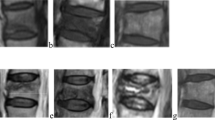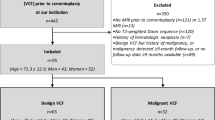Abstract
Objective
To compare the diagnostic accuracy of 3-T magnetic resonance imaging (MRI) with thin-slice 3D T1 VIBE sequence to 128-slice computer tomography (CT) in pars stress fractures of the lumbar spine.
Materials and methods
3-T MRI and CT of 24 patients involving 70 pars interarticularis were retrospectively reviewed by four blinded radiologists. The fracture morphology (complete, incomplete, or normal) was assessed on MRI and CT at different time points. Pars interarticularis bone marrow edema (present or absent) was also evaluated on MRI.
Results
In total, 14 complete fractures, 31 incomplete fractures and 25 normal pars were detected by CT. Bone marrow edema was seen in seven of the complete and 25 of the incomplete fractures. The overall sensitivity, specificity and accuracy of MRI in detecting fractures (complete and incomplete) were 97.7, 92.3, and 95.7 %, respectively. MRI was 100 % accurate in detecting complete fractures. For incomplete fractures, the sensitivity, specificity, and accuracy of MRI were 96.7, 92.0, and 94.6 %, respectively.
Conclusions
3-T MRI with thin-slice 3D T1 VIBE is 100 % accurate in diagnosing complete pars fractures and has excellent diagnostic ability in the detection and characterization of incomplete pars stress fractures compared to CT. MRI has the added advantages of detecting bone marrow edema and does not employ ionizing radiation.





Similar content being viewed by others
References
Jackson D, Wiltse L, Cirincione R. Spondylolysis in the female gymnast. Clin Orthop. 1976;117:658–73.
Soler T, Calderon C. The prevalence of spondylolysis in the Spanish elite athlete. Am J Sports Med. 2000;28:57–62.
Kim H, Green D. Spondylolysis in the adolescent athlete. Curr Opin Pediatr. 2011;23:68–72.
Kruse D, Lemmen B. Spine Injuries in the sport of gymnastics. Curr Sports Med Rep. 2009;8:20–8.
Elliot S, Hutson M, Wastie M. Bone scintigraphy in the assessment of spondylolysis in patients attending a sports injury clinic. Clin Radiol. 1988;39:269–72.
Lowe J, Schachner E, Hirschberg E, et al. Significance of bone scintigraphy in symptomatic spondylolysis. Spine. 1984;9:653–5.
Bellah R, Summerville D, Treves S, et al. Low back pain in adolescent athletes: detection of stress injury to the pars interarticularis with SPECT. Radiology. 1991;180:509–12.
Campbell R, Grainger A, Hide I, et al. Juvenile spondylolysis: a comparative analysis of CT, SPECT and MRI. Skeletal Radiol. 2005;34:63–73.
Hollenberg G, Beattie P, Meyers S, et al. Stress reactions of the lumbar pars interarticularis: the development of a new MRI classification system. Spine. 2002;27:181–6.
Ganiyusufoglu A, Onat L, Karatoprak O, et al. Diagnostic accuracy of magnetic resonance imaging versus computed tomography in stress fractures of the lumbar spine. Clin Radiol. 2010;65:902–7.
Leone A, Cianfoni A, Cerase A, et al. Lumbar spondylolysis: a review. Skelet Radiol. 2011;40:683–700.
Kobayashi A, Kobayashi T, Kato K, et al. Diagnosis of radiographically occult lumbar spondylolysis in young athletes by magnetic resonance imaging. Am J Sports Med. 2013;41:169–76.
Zheng Z, Shan H, Li X. Fat-Suppressed 3D T1-weighted gradient-echo imaging of the cartilage with a volumetric interpolated breath-hold examination. AJR. 2010;194:W414–9.
Thomson V, Pialat J, Gay F, et al. Whole-body MRI for metastases screening: a preliminary study using 3D VIBE sequences with automatic subtraction between non contrast and contrast enhanced images. Am J Clin Oncol. 2008;31:285–92.
Blanda J, Bethem D, Moats W, et al. Defects of pars interarticularis in athletes: a protocol for nonoperative treatment. J Spinal Disord. 1993;6:406–11.
Steiner M, Micheli L. Treatment of symptomatic spondylolysis and spondylolisthesis with the modified Boston brace. Spine. 1985;10:937–43.
Morita T, Ikata T, Katoh S, Miyake R. Lumbar spondylolysis in children and adolescents. J Bone Joint Surg (Br). 1995;77:620–5.
McCleary M, Congeni J. Current concepts in the diagnosis and treatment of spondylolysis in young athletes. Curr Sports Med Rep. 2007;6:62–6.
Dunn A, Campbell R, Mayor P, et al. Radiological findings and healing patterns of incomplete stress fractures of the pars interarticularis. Skelet Radiol. 2008;37:443–50.
Author information
Authors and Affiliations
Corresponding author
Ethics declarations
Conflict of interest
The authors declare that they have no conflicts of interest.
Rights and permissions
About this article
Cite this article
Ang, E.C., Robertson, A.F., Malara, F.A. et al. Diagnostic accuracy of 3-T magnetic resonance imaging with 3D T1 VIBE versus computer tomography in pars stress fracture of the lumbar spine. Skeletal Radiol 45, 1533–1540 (2016). https://doi.org/10.1007/s00256-016-2475-7
Received:
Revised:
Accepted:
Published:
Issue Date:
DOI: https://doi.org/10.1007/s00256-016-2475-7




